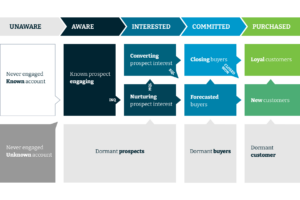No more silos
A MarketOne white paper written for web

Orchestrating UBX framework: an overview
Getting to grips with the Unified Buyer Experience (UBX)
MarketOne’s UBX approach provides a strategic framework that can be applied to any organization, at any point in its quest towards a silo-free organizational structure. It sits across existing silos and connects experiences internally for organizations and externally for customers. Not only is the UBX framework a tool to benchmark current marketing and sales effectiveness, but it can also show you the areas where you should next invest valuable time and resources. For instant feedback, go directly to MarketOne’s free UBX assessment here.
ABM is the driving force behind UBX, providing the strategic approach and overarching alignment between marketing and sales as they act as a united front, armed with deep buyer insight to effectively engage. ABM, according to ITSMA (who coined the term in 2003), …” combines targeted, insight-led marketing with sales to increase mindshare, strengthen relationships, and drive growth in an identified set of target accounts.”
One of the ways you can segment is by customer journey (see box out below) that begins when your prospect has no awareness of your brand, up to a repeat, loyal customer, mapping every single human and digital interaction in between.
Activation of the customer journey segment is achieved with a coordinated and aligned approach from marketing, sales and services. Once a strategy and targets based on business need have been agreed, marketing might reach out and engage the prospect with scaled omnichannel digital engagements such as paid ads and syndication, microsites and landing pages and nurture campaigns. Sales development might use one-to-one digital interactions via a targeted email campaign and social selling, as well as personalized interactions such as calling, online chat to surround the buyer with a 360-degree experience. Together, marketing and sales align and boost each other to increase reach, engagement and conversion. Messaging, data, and content are coordinated, and one effort amplifies the other.
The result is no more siloed buyer interactions. Instead, selling and marketing efforts are planned in a way that engages a customer segment with the right message, through the right channels, at the right time – delivering a superior Unified Buyer Experience.
How to use customer journey-based segmentation
MarketOne’s customer journey segmentation framework is a useful way of mapping your prospects and customers, ‘bucketing’ them based on their stage in the typical buyer journey. This approach has several advantages:
- Rather than needing multiple data points to create your segment, you only need one: where are your contacts in the buying process?
- There’s no need to address all the segments at the same time – focus on where the numbers are the greatest, or where you can have the biggest impact.

- Each bucket or segment represents a different set of campaigns and messaging, but with the same goal: to move contacts to the next most appropriate segment.
- Using this framework means that no segment is left untouched, and it works whether you’d conducting one-to-many or one-to-one communication.
- Engagement is measured by movement through the journey, providing greater insight into successes and failures than traditional waterfall metrics.
What about the challenges in delivering UBX? I’m not sure my organization is ready?
What won’t change in the future is what has made us successful in B2B in the past — that is alignment. We need to work together to embrace what the future will bring because alignment is the key to growth, and it’s also the key to having the kind of organization we want to be a part of.”
Megan Heuer, VP of Research for Forrester, SD Summit 2019
While trying to eliminate silos is an admirable goal, in many organizations, getting rid of them entirely is not realistic in the short-term. Rather, businesses should work across silos, strengthening cross-communication between departments, clarifying roles, centralizing data and unifying marketing channels.
The problem with silos is recognizing them
Just 15% of companies recognize the need to break down silos [Forrester] but it’s a task that successful start-ups, led by software-as-a-service (SaaS) providers, have already started to address. Revenue Operations (RevOps) means marketing, sales and services are all responsible for driving revenue and are centralized under the Chief Revenue Officer (CRO). This aligns planning, processes, technology, data and measurement to accelerate revenue growth and go-to-market operations efficiency. Forrester believes RevOps is the future because: “Organizations that align their revenue engine pre- and post-sale grow faster and more profitably than those that aren’t aligned. Revenue operations makes alignment easier by defining a clear set of accountabilities and actions, then formalizing the elements that expand the potential for alignment to succeed.”
Siloed data, tech and organizational structure
Other issues include siloed data – perhaps you have gaps in your contact data related to target accounts? Or siloed tech – do you have too many martech tools, each collecting data that isn’t held centrally, and so isn’t being leveraging as it should? There could also be cultural challenges within your organization – teams may not trust each other, and new processes can be difficult to implement if they come up against a culturally accepted way of operating.
Orchestrating UBX: how to get started
UBX is a roadmap for success that can help organizations start to internally align without necessarily making a large investment, having a perfect data set or a comprehensive tech stack. We take a crawl, walk and run approach, as it can be applied to businesses of every level of maturity.
Applying the framework to your organization and implementing the proposed processes and governance will aid you in identifying gaps and new opportunities so that you can fix what you can, even if it’s small, to make an impact. As your organization’s infrastructure begins to integrate and you are able collect more data, it will support you on your journey towards greater unification and superior buyer – and seller experience.

MarketOne has identified seven core pillars to deliver a unified experience for the buyer in today’s multi-dimensional buyer journey. Let’s take each of these in turn.
It’s likely that you won’t address these pillars in this sequential order; rather you will probably have many campaigns and strategies running simultaneously and will be at a different level of maturity for each.
You will recognize many of the elements highlighted as core tools in delivering an Account Based Marketing (ABM) campaign. UBX unites all the elements of ABM to create an organic journey, driven jointly by the different stakeholders within your organization.